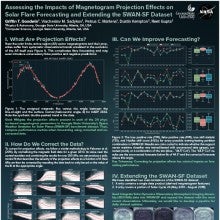Assessing the Impacts of Magnetogram Projection Effects on Solar Flare Forecasting and Extending the SWAN-SF Dataset
Griffin
Goodwin
Georgia State University
Poster
Active region (AR) vector magnetograms are frequently used to forecast solar flares as they provide an excellent source of preflare features that can be easily integrated into machine learning models. However, as ARs traverse farther from the solar disk center, the quality of magnetic field data degrades substantially. Near the limbs, magnetograms suffer from projection effects, which introduce observed long-term systematic trends to the data, unrelated to the evolution of the AR itself. These artificial variations complicate forecasting and may even introduce unnecessary false positive and negative predictions. To study the impacts of this issue on forecasting, we utilize a methodology proposed by Falconer et al. (2016) to correct for projection effects present in Georgia State University’s Space Weather Analytics for Solar Flares (SWAN-SF) benchmark data set. We then compare performance metrics across the corrected and uncorrected data. Our analysis shows that both the true positive and false positive prediction rates only increase slightly after corrections are applied, averaging a few percent. This suggests that projection effects do not have a large impact on forecasting, or a more complicated correction methodology may be needed to see improvements. It may also indicate that there are inherent limitations when using magnetogram data for flare forecasting. Therefore, our current efforts are focused on extending the data products of SWAN-SF by incorporating extreme ultraviolet (EUV) descriptors of ARs, with the hope of improving forecasting near the limb. Preliminary results for this project will also be reported on.

Poster PDF
Poster category
Solar and Interplanetary Research and Applications
Meeting homepage